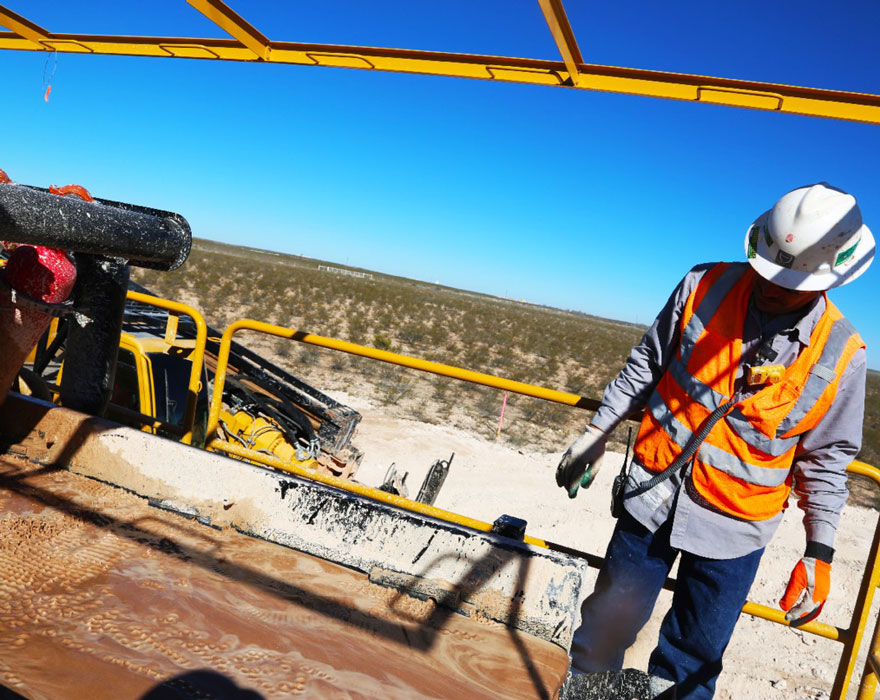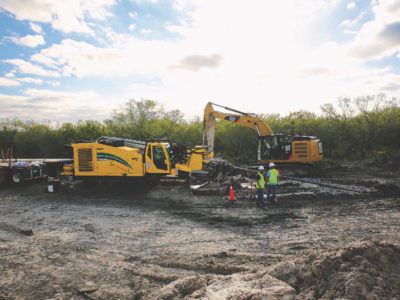Keeping yourself and the rest of the crew safe on the job needs to be a top priority every single day. And, when you’re working on a maxi rig directional drilling crew, there is a lot you need to pay attention to.
Jobsite safety starts with you
Whether you’re new on the job, or you’ve been working around maxi rigs your whole life, jobsite safety starts with taking care of yourself. You need to make sure you’re wearing all the jobsite’s personal protective equipment (PPE), which typically includes:
- A safety vest, shirt, sweatshirt, etc.
- Electrical hazard-rated safety boots
- Safety glasses
- Earplugs
- A hard hat, of course
- And, on some jobsites, fire retardant (FR) clothing
Besides making sure you’re wearing PPE, Vermeer Pipeline Solution Specialist Kelly Beller says it’s essential to show up every day ready to work and react to potential safety hazards. “Large-diameter horizontal directional drilling (HDD) projects involve a lot of moving machinery. There are open pits for collecting slurry and potholing existing utilities, pipe is being slung into position. Everyone’s got to pay attention to their surroundings and be ready to react.”

Understand the specific jobsite safety requirements
When you’re working a large-diameter HDD, no two projects are the same, and most have specific requirements based on potentially hazardous conditions. With that said, you need to make sure all personnel permitted on the jobsite has been properly trained on any equipment they are operating and job they are performing.
According to Vermeer Application Engineer, Marvin Klein, municipality projects like installing water and sewer may have specific safety requirements based on what’s happing around the jobsite — above and below ground. But, on oil and gas pipeline work, several other safety hazards play a part in what safety protocols are in place. “An HDD crew is just part of several companies working on a pipeline, and they must all adhere to the OSHA and any safety protocols outlined by the project owner,” he said. “While an assigned safety coordinator is responsible for making sure every safety procedure is being followed, that person needs each individual to do their part, too.”
Klein added, “Holding regular safety meetings (daily on most projects) is a great way to make sure everyone is completely aware of what jobsite safety precautions are expected of them. These meetings aren’t just about telling everyone on the crew what they must do. It should also be a time for people to ask questions and share any concerns they have.”
Have a jobsite safety plan
Based on specific jobsite safety requirements, HDD crews should develop a safety plan that gets shared with everyone before work begins. “In addition to outlining safety guidelines, the plan should outline what to do in the event of an emergency. Safety plans should include details like who to call in the event of a utility strike, mitigation steps to take in the event of an inadvertent return, and where a crew member should go in the event of a fire or natural disaster,” said Beller. “Don’t leave anything to chance. Safety plans should include as much detail as possible, so everyone knows what is expected of them.”
Communication is essential for jobsite safety
Along with regular safety meetings and a safety plan, communicating on the job is critical. “Since large-diameter HDD projects are more spread out and involve larger crews than the typical utility bore, everyone on the crew should be in constant communications,” Klein recommended. “It’s important for the drill operator to be able to communicate with drill rod handlers and the folks recycling drilling fluids throughout the day. Give everyone the ability to communicate about what is happening with their part of the operations to help with jobsite efficiency.”
June is National Safety Month. Make sure you’re doing your part to keep safety top of mind this month — and every month. If you have any questions about working around HDD equipment, contact your local Vermeer dealer for support or review your machine’s operator’s manual. You can learn more about Vermeer equipment at vermeer.com.
Vermeer Corporation reserves the right to make changes in engineering, design and specifications; add improvements; or discontinue manufacturing at any time without notice or obligation. Equipment shown is for illustrative purposes only and may display optional accessories or components specific to their global region.
Please contact your local Vermeer dealer for more information on machine specifications. Vermeer and the Vermeer logo are trademarks of Vermeer Manufacturing Company in the U.S. and/or other countries.
© 2021 Vermeer Corporation. All Rights Reserved.
